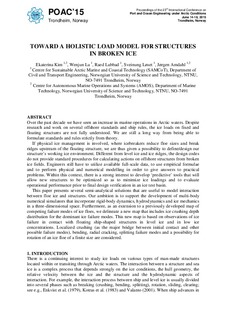Toward a holistic load model for structures in broken ice
Journal article, Peer reviewed
Published version
Permanent lenke
http://hdl.handle.net/11250/2468730Utgivelsesdato
2015Metadata
Vis full innførselSamlinger
- Institutt for bygg- og miljøteknikk [4769]
- Institutt for marin teknikk [3472]
- Publikasjoner fra CRIStin - NTNU [38688]
Originalversjon
Proceedings - International Conference on Port and Ocean Engineering under Arctic Conditions. 2015, 2015-January .Sammendrag
Over the past decade we have seen an increase in marine operations in Arctic waters. Despite research and work on several offshore standards and ship rules, the ice loads on fixed and floating structures are not fully understood. We are still a long way from being able to formulate standards and rules strictly from theory. If physical ice management is involved, where icebreakers reduce floe sizes and break ridges upstream of the floating structure, we are thus given a possibility to define/design our structure’s working ice environment. Different from level ice and ice ridges, the design codes do not provide standard procedures for calculating actions on offshore structures from broken ice fields. Engineers still have to utilize available full-scale data, to use empirical formulae and to perform physical and numerical modelling in order to give answers to practical problems. Within this context, there is a strong interest to develop ‘predictive’ tools that will allow new structures to be optimized so as to minimize ice loadings and to evaluate operational performance prior to final design verification in an ice test basin. This paper presents several semi-analytical solutions that are useful to model interaction between floe ice and structures. Our ambition is to support the development of multi-body numerical simulators that incorporate rigid-body dynamics, hydrodynamics and ice mechanics in a three-dimensional space. Furthermore, as an extension to a previously developed map of competing failure modes of ice floes, we delineate a new map that includes ice crushing depth distribution for the dominant ice failure modes. This new map is based on observations of ice failure in contact with floating ship-shaped structures in level ice and in low ice concentrations. Localized crushing (as the major bridge between initial contact and other possible failure modes), bending, radial cracking, splitting failure modes and a possibility for rotation of an ice floe of a finite size are considered.
